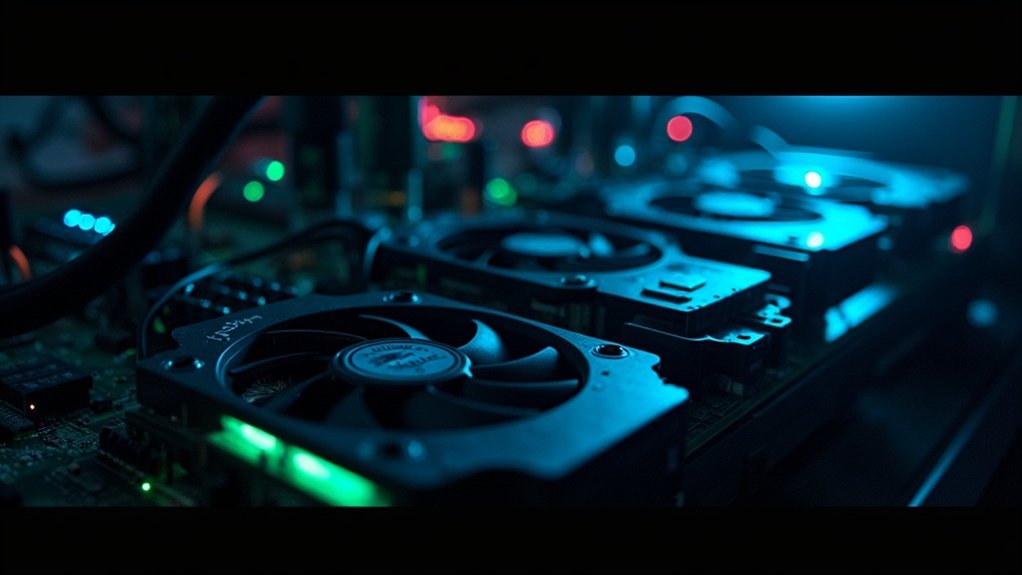Bitcoin nodes and full nodes aren’t the same thing. All full nodes are nodes, but not all nodes are full nodes. Full nodes store and validate the entire blockchain, independently verifying every transaction against protocol rules. Regular nodes may have limited capabilities. Full nodes are storage hogs but essential for security, privacy, and maintaining Bitcoin’s decentralization. They reject invalid transactions and prevent double-spending. Lightweight nodes sacrifice security for convenience. The difference matters more than most realize.
When discussing Bitcoin’s network infrastructure, confusion often arises between the terms “node” and “full node.” They sound similar. They’re frequently used interchangeably. But there are vital distinctions worth understanding.
A node is simply any computer connected to the Bitcoin network that participates in data exchange. That’s it. Nothing fancy.
Full nodes, however, go the extra mile by storing and validating the entire blockchain, meticulously checking that every transaction follows Bitcoin’s protocol rules. They’re the network’s hall monitors, clipboard and all.
Full nodes are Bitcoin’s diligent gatekeepers, scrutinizing every transaction with unwavering attention to protocol compliance.
Storage requirements separate these network participants dramatically. Full nodes maintain the complete blockchain history—every transaction since Bitcoin’s genesis block. It’s a storage hog. Archival nodes take this even further by storing complete transaction history for services like block explorers.
Pruned nodes, meanwhile, validate everything but only keep recent data, deleting older blocks to save space. Light nodes? They’re the minimalists, downloading only block headers. Barely participating, really. Similar to Solana’s speed, these light nodes prioritize efficiency over comprehensive validation.
Full nodes provide unmatched security. They independently verify everything, rejecting invalid transactions and preventing double-spending attempts.
Lightweight nodes, by comparison, must trust others for validation. Not ideal if you value security. Businesses and privacy-focused users can’t afford to cut corners here.
Privacy is another big deal. Running a full node keeps your financial business private. Lightweight clients leak address information to third-party servers. Might as well post your transaction history on social media.
Miners and nodes maintain a symbiotic relationship. Full nodes validate transactions and maintain mempools of unconfirmed transactions.
Miners then select from these pools, perform their proof-of-work magic, and compete for block rewards. Once a block is mined, full nodes validate it again. Double-checking. Always double-checking.
The Bitcoin network needs both types of participants. But full nodes are the backbone.
They preserve decentralization, maintain consensus, and keep the network honest. Running a full node contributes to Bitcoin’s economic strength by enforcing consensus rules independently from miners. Without them, Bitcoin’s trustless nature crumbles. And nobody wants that.
Frequently Asked Questions
How Much Internet Bandwidth Does a Bitcoin Node Require?
A Bitcoin full node is hungry for bandwidth.
We’re talking 200GB upload and 20GB download monthly on average broadband. That’s serious data.
Initial sync? A whopping 340GB download.
Lightning Network nodes demand even more – up to 2TB monthly.
Minimum upload speed needs to be around 400 kbps, but realistically, 100Mbps connections are ideal.
Pruned nodes use less bandwidth, thankfully.
Definitely not for those with data caps.
Can I Run Multiple Bitcoin Nodes on the Same Hardware?
Yes, multiple Bitcoin nodes can run on the same hardware. It’s totally doable.
Each node needs its own data directory and unique ports though. The real question: is the hardware up to snuff? You’ll need serious CPU power, plenty of RAM (8-16GB per node), and tons of storage space—we’re talking 600GB+ per node.
Network bandwidth gets stretched thin too. Some folks use Docker to keep things organized. Not for the faint of hardware.
What Happens if My Node Goes Offline Temporarily?
When a node goes offline temporarily, it’s not the end of the world. The blockchain continues functioning through other nodes. Upon reconnection, the node simply downloads and verifies all missed blocks.
Network integrity remains intact, though widespread outages can slow things down a bit. Sudden shutdowns might corrupt data, requiring re-syncing.
Power issues, SD card corruption, and resource constraints are common culprits behind temporary offline states. Regular maintenance helps minimize these interruptions.
No big deal, usually.
Do Bitcoin Nodes Earn Rewards Like Miners Do?
No, Bitcoin nodes don’t earn rewards like miners. Not a cent.
While miners collect block rewards and transaction fees for their computational work, nodes get zilch from the protocol itself. They just validate transactions and relay blocks – vital work, but unpaid.
People run nodes for different reasons: enhanced privacy, network security, or plain old ideological support for decentralization. Some businesses need them for operations.
But rewards? Nope. That’s mining territory.
How Do I Test if My Bitcoin Node Is Working Correctly?
To test a Bitcoin node’s functionality, check connectivity to multiple peers and blockchain synchronization status using RPC commands like `getblockchaininfo`.
Send a test transaction to verify mempool acceptance. Review logs for errors. Monitor resource usage. Cross-verify block data with explorers.
Run validation commands like `verifychain`. Proper nodes connect to peers, validate transactions, relay blocks, and maintain the blockchain without issues.
No rewards for running nodes—just the satisfaction of supporting the network.









